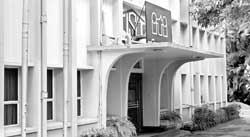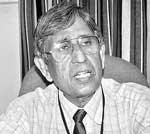| Sri Lanka’s
premier R & D facility moves on to bigger things
By Lakwimashi Perera
After 50-years of working amidst the
hustle and bustle of Colombo city, the Industrial Technology
Institute (ITI) formerly known as the Ceylon Institute
for Scientific and Industrial Research (CISIR) is finally
moving to a state of the art facility that is worthy
of the 21st century.
 |
| The present and original location
which is 55-years old |
The new premises will be a welcome
departure from the honking horns and passing traffic
that has always disturbed the scientists’ thought
process.
The ITI, currently located in Colombo
7 near the BMICH, is relocating to the Technology Park
in Malabe.
ITI Director/CEO Dr Azeez M. Mubarak,
hailing the move, said, “the Colombo 7 area is
a very expensive place and it is not an area where you
can do research and development because research and
development requires expansion.”
Initially, the plan was to build a
Japanese funded state of the art Food Technology Lab
in the Colombo premises itself, but as a result of the
area where the ITI is currently located being identified
as an Independence Square Development Area, preventing
high rise buildings from being erected, that proposal
had to be scrapped. The new facility will be situated
on a 10 acre block of land in Malabe that was granted
to the ITI by the government.
Pointing out another positive outcome
of the move, Dr Mubarak explained that 80 per cent of
industries are in Colombo and the Western Province.
Due to this, everyone gets attracted to this area creating
other problems.
He pointed out workers who come to
Colombo looking for jobs and as a result, spend most
of their salaries on accommodation as an example. According
to him, most of the ITI staff are from the outstations,
requiring long hours of travel to get to and from work.
 |
| Dr Azeez M. Mubarak |
When they get to work they are tired
and not in a position to work. “These are all
issues. People don’t realize the real issues.”
Dr Mubarak explained that in R & D there is no “9
to 4.45 (hour)” limit but that he cannot force
people to work late as they have other personal matters
to attend to. “The move might help because we’re
going to have accommodation for the scientists.”
He says scientists have to be given
the correct environment and a conducive atmosphere to
think.
The proposed facility will have a
park atmosphere, similar to a Western facility, with
a lot of greenery to help create an environment where
the scientists can peacefully engage in their work.
A requirement of the Malabe Park is
for buildings to be high rise but Mubarak shows a preference
for a lay out that requires his staff to walk from building
to building. Hence, the new complex is designed so that
the buildings are spread out instead of rise up in the
10 acres. “Even in the West, the latest trend
is to have buildings far away so that people must walk.”
The new proposed facility will include such facilities
like a swimming pool, a herb garden, tennis courts etc.
These facilities are designed to make the staff feel
at ease and create an environment conducive to peaceful
thought and also build team spirit.
The ITI has made a request to the
UDA for a building plan that is not congested and have
adequate spacing between the buildings.
The shift is spread out over a period
of 10 years with construction beginning with the Japanese-funded
Food Technology lab. The government is funding the building
of the administration building and is also providing
the funds for the land.
The total required to complete the
project over a period of 10 years will be Rs 3.5 billion.
“We will identify specific blocks and look for
foreign grants,” The ITI director said, adding
that he is confident that he could get the project going
and seek the necessary funds.
Asked about the perennial problem
of an exodus of qualified personnel from the state sector
looking for greener pastures in the private sector,
Dr Mubarak stated that R & D of the private sector
has not developed to an extent where it has lured ITI
employees but admitted that better pay in the private
sector has resulted in loss of qualified personnel –
to other jobs. “For example a chemist may become
a banker in the private sector” he said. When
asked what is being done to curb this problem he said
that the Minister for Science and Technology, Prof.
Tissa Vitharana is fighting for a bigger budget to secure
competitive salaries for experts so as to retain them.
“It is a loss for the country
to train people as scientists – after investing
so much money from primary education to University level
– when they go into different fields,” he
said.
He also said that many qualified Sri
Lankans are going overseas as they get much, better
salary packages.
Currently the ITI is trying different
ways of attracting professionals. One is to try to get
Sri Lankan scientists living abroad to work in Sri Lanka
for short periods. At the moment they come for a very
short period.
“We want them to come for at
least 1 – 2 years, but again, the issue of salaries
comes in.
For them to come here, they need to
be offered salaries similar to what they receive abroad.”
The ITI director said a small section
of the ITI will remain at its current location which
would have a marketing unit, a library and maybe a small
testing facility so that the industry would be linked
to the Malabe facility, when it is up and running.
Food research facilities limited
Dr. M. G. M. U. Ismail, Deputy
Director (Research & Development), echoing
Dr. Mubarak, told us that the move will allow
ITI to expand.
He said R & D is an investment
but that at the moment the investment is about
0.15% of the GDP on R & D. Making a comparison,
he said that developing countries close to Sri
Lanka spends 1% and sometimes even around 3% on
R & D.
“For example, in the food
area the facilities are limited. When the ITI
develops something we have to give it to small
and medium industry. For them to invest they need
a test marketing strategy to find out whether
the product will be successful in the market,
before he makes his investment.” In the
new facility they expect to have such a pilot
plant so that they can lease or rent it out to
the industries for a short period of time, with
the ITI providing the technology and the know-how
and the entrepreneur can test it with his staff.
The private sector in Sri Lanka is rather weak
and the culture is not oriented towards R &
D. The same product is marketed without any diversity,
because the present culture is not new- product
oriented. With the move, and the availability
of new technology he expects a cultural change
to come about with more private sector involvement.
|
|
